9. Airplane (1980) dir. Jim Abrahams, David & Jerry Zucker

Zucker, Abrahams and Zucker’s satirical parody film of the disaster genre is known for its use of surrealist humour, slapstick puns and sound effect gags. Of course, one of its most recognisable sequences is Ted Striker’s (Robert Hays) flashback to the ruddy disco where he first met now-ex-girlfriend Elaine Dickinson (Julie Hagerty).
Nervous-flyer Striker explains his relationship to the air stewardess (i.e. Elaine) to the old lady sitting next to him, Mrs. Elderly. She understands why he’s upset, hilariously saying that “She’s lovely. And a darling figure. Supple, pouting breasts. Firm thighs. It’s a shame you’re not getting along.” To which, he replies “Yes, I know. Things used to be different. I remember when we first met. It was during the war.”
We dissolve to the smoke-filled Magumba Bar where there is an array of unsavoury characters, just a beat away from breaking out into a fight. A girl scout’s head gets bashed against the jukebox by another girl scout- leading the Bee Gees’ hit “Stayin’ Alive” to start blaring off at +10% faster than its normal speed. The drunken patrons start dancing “a la John Travolta”, amongst which there is a red-dressed Elaine joyfully mirroring the moves of an unknowingly, stabbed, dying man.
Striker is captivated, entranced by her presence. He dramatically walks up to her and the two share a blissfully cheesy moment of what is often described as ‘love at first sight’. They make a perfect disco couple, despite obviously never rehearsing their impeccable routine before, and the other dancers make a circle around them Saturday Night Fever style. They begin with fancy disco steps, Striker does Travolta-white-suit-reveals, and the two go on to perform seemingly impossible acrobatic stunts underneath the shining disco ball.
“We laughed, we talked, we danced, I never wanted it to end and I guess I still don’t. But enough about me. I hope this hasn’t been boring for you.” And the camera widens to reveal Mrs. Elderly’s legs dangling next to him. She has hung herself.
The scene makes multiple references to the 1977 musical drama “Saturday Night Fever,” through its usage of the Bee Gees, disco dance grooves, outfits and setting. Of course, in ZAZ fashion, the whole thing is blown out in the most exaggerated way to induce humour, especially by intentionally undermining stereotypically gendered dance moves, like when Elaine lifts Striker up rather than Striker lifting Elaine. Finding funniness in the unexpected.
The film as a whole is a reference and parody of Hal Bartlett’s 1957 airplane flick “Zero Hour!” of which “Airplane!” lifts dialogue from almost verbatim.
(Bonus: The disco scene was recreated in Seth MacFarlane’s 2012 “Ted”).
Literary References:
Jim Abrahams, David & Jerry Zucker. “Airplane!” Screenplay (1980)
10. The Big Lebowski (1998) dir. Joel & Ethan Coen
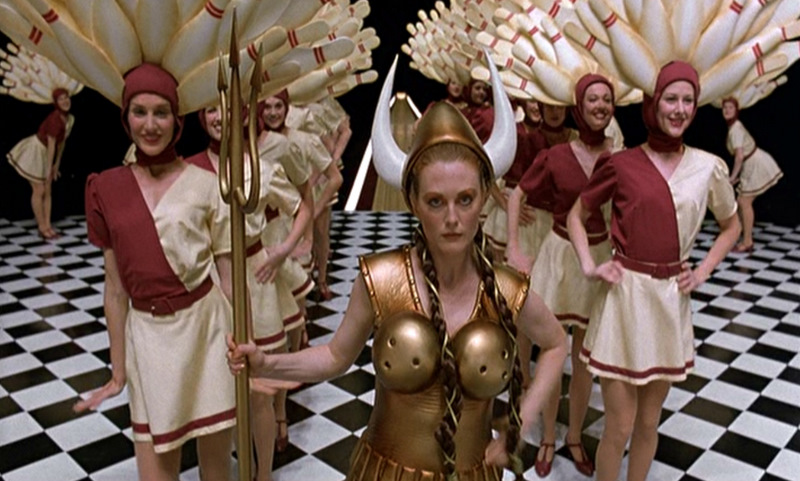
The Dude’s (Jeff Bridges) trusted White Russian has been spiked by Mr. Jackie Treehorn (Ben Gazzara) and we enter the second dream sequence of the film.
“Darkness washed over the Dude. Darker than a black steer’s tookus on a moonless prairie night. There was noooo bottom.”
An animated bowling pin passes in between two bowling bowls as the titles open what seems to be another movie within the movie.
“Jackie Treehorn Presents… The Dude…. Maude Lebowski… In… ‘Gutterballs’.”
Or rather, a music video within the movie.
Kenny Rogers and the First Edition’s counterculture psychedelic pop song, “Just Dropped In (To See What Condition My Condition Was In)” begins as we arrive in the Dude’s subconscious. The song itself is said to reflect the LSD experience, so it’s more than a perfect fit with his drug-induced meta dream sequence.
The Dude exaggeratedly walks slash dances with the rhythm of the tune, casting a large Noir-esque shadow on the massive wall, a visual which purposely calls back to a previously odd dance sequence earlier in the movie where his Landlord interpretively dances to “Pictures at an Exhibition”, itself being very reminiscent of Fellini’s “Satyricon”. Since the dream takes place in his subconscious, every visual originates from a visual seen in his real life, mirroring how dreams tend to actually work.
Next, a Saddam Hussein look-a-like scans the infinite library of red-and-black bowling shoes that skyrockets straight up to the full moon. The appearance of Hussein refers to the ongoing Kuwait war crisis that is heavily featured in the background of the film.
The Dude is wearing an oddly discordant outfit compared to his usual robe-getup. It’s an all-white workman outfit with the sleeves cut off with a thick tool belt, the same outfit worn by Karl Hungus (Peeter Stormare) in the earlier “Logjammin” sequence on TV in Maude’s apartment (the porno is also purposely produced by the same Jackie Treehorn and is another diegesis example of a movie within a movie).
An ecstatically elated Dude received gold and silver bowling shoes from Hussein and then is seen grooving down the lit-up black-and-white tiled grand staircase that exists in space. Shuffling his feet, and rocking his hips, the staircase leads to a similarly designed stage with loads of back-up dancers with extravagant bowling-pin-headpieces on and the lovely Maude (Julianne Moore) in a short, golden Viking-Gladiator ensemble with a three-pronged spear. Working like a rehearsed epic Broadway production, all the dancers look like they’re been pulled out of 42nd Street.
The black-and-white tiling mirrors the floor of the entryway of the Big Lebowski’s (David Huddleston) house. Maude’s trident is also taken from a statue seen at his house. While the red-on-black bowling ball he use to teach Maude how to bowl was previously seen in the first dream sequence, and may be seen in ‘real’ life on the rack in the bowling alley. This form of self-reference is a common theme in the film, with the Dude also having the habit of repeating phrases he hears from other characters.
All in all, this scene really ties the movie together.
(Bonus: Yet another impromptu dance scene in the film is when we are introduced to the Dude’s bowling archnemesis Jesus Quintana who victoriously dances backwards a la Muhammad Ali to a flamenco version of The Eagles’ “Hotel California”. The Dude hates The Eagles).
11. Young Frankenstein (1974) dir. Mel Brooks

Bucharest Academy of Science Presents, for one night only:
THE CREATURE in “A Startling New Experiment in Reanimation”
Presented in cooperation with TNS (Transylvania Neurological Society)
Dr Frederick Frankenstein (Gene Wilder), the grandson of the infamously mad scientist Victor Frankenstein, projects his clear voice throughout the full auditorium. The audience of professional peers are all clad in tuxedos and their best fur. This is an event. “Ladies and Gentlemen, Mesdame et Messieurs, Damen und Herren, from what was once an inarticulate mass of lifeless tissues, may I now present a cultured, sophisticated man about town!”
Blackout.
And then: Frankenstein and the Creature (Peter Boyle) appear in centerstage spotlight with tops-and-tails tuxedos and canes. Frankenstein sings Irving Berlin’s “Puttin’ on the Ritz” from the 1930 musical of the same name, while the duo perform a tap dance routine demonstrating the creature’s fine motor skills and intelligence- that is, until one of the candles lining the edge of the stage shatters, thereby triggering the Creature’s pyrophobia. The audience does not react well.
This is Mel Brooks’ amazing comedy-horror film “Young Frankenstein”, a sophisticated parody of the classic horror film genres, specifically of the various film adaptations of Mary Shelley’s novel “Frankenstein” produced by Universal in the 1930s.
The ‘70s film pays credit to these previous adaptations by shooting the entire film in black-and-white glory (Brooks in fact switched from Columbia Pictures to 20th Century Fox over Columbia’s issues with the monochromacy) as well as using antiquated scene transitions such as wipes, fades to black, and iris outs, and ‘30s style opening credits.
The film has been highly revered, with the American Film Institute including it at number 13 on their list of “100 Years…100 Laughs”, and included their version of “Puttin’ on the Ritz” at number 89 on their “100 Years…100 Songs” list.
12. Little Miss Sunshine (2006) dir. Jonathan Daton & Valerie Faris
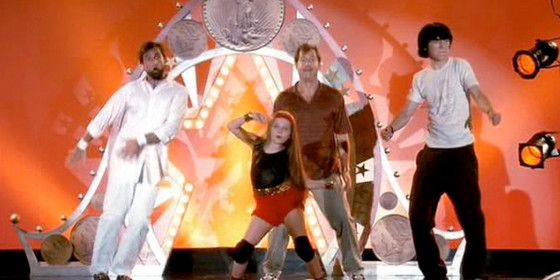
After a tumultuous two-day journey from Albuquerque, New Mexico to Redondo Beach, California in a semi-functioning yellow Volkswagen Type 2, the Hoover family finally make it to Olive’s (Abigail Breslin) “Little Miss Sunshine” beauty pageant. She’s been practicing with her heroin-addicted, foul mouthed grandfather (the hilarious Alan Arkin) who teaches her the choreography for her talent section.
In the culmination of the comedy-drama Sundance flick, Olive takes the stage and obliviously performs a quirky burlesque performance to Rick James’ 1981 funk hit “Super Freak (Rocasound Revamp)”.
The judges and audiences are horrified by the inappropriate stripper-like quality of her routine but Olive’s having so much fun twirling round and round with her red tie in her mouth, long hair swinging behind her, that she barely notices. The rest of her family, who like the audience, has been left in the dark about her dance routine are equally as shocked, but root her on anyways because they love her.
Audience members start leaving, her family starts clapping. Her golden sneakers tap against the floor as fast as they can. One judge gets so upset she tries to get Olive off the stage, but her father (Grey Kinnear), her mother (Toni Colette), her mute brother (Paul Dano) and suicidal uncle (Steve Carell) come to her rescue by joining in and supporting the precious Olive. Thinking: it’s okay if she’s a bit weird, because they are all weird together as a family. Normality is overrated so might as well dance on stage and piss the judges off.
13. Inland Empire (2006) dir. David Lynch
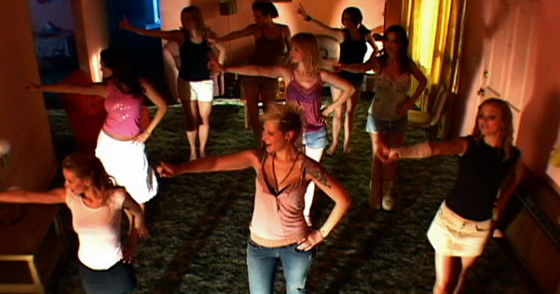
Known for his polarising surrealist elements, Lynch cuts through this 180 minute long film that most people have trouble figuring out with a 50-second high contrast dance routine performed by one-off characters in a small overly lit apartment. The troupe of nine unknown girls perform an impromptu, but synchronistically choreographed dance to Little Eva’s 1962 rendition of the earworm pop song “The Loco-Motion”.
The shaggy green carpet looks like rotting moss, the figures cast massive shadows on the cream walls, and the lights start to flicker in tune with the beat. Strobe magic in what seems (most probably, who knows with Lynch) to be in our protagonist’s, actress Nikki Grace / Susan Blue’s (Laura Dern) dichotomised mind.
She stares, half her face in what seems to be the sun shining glazing through the apartment. Her red lips are parted in confusion, her eyes focused on the weird insanity of what is happening before her. Confusion reigns Inland Empire, with neither one of the stars (Dern and Justin Theroux) actually understanding the film’s premise.
Marketing executives were even so puzzled by the drama and were at a loss as to how to promote it. They eventually chose the tagline, “A Woman in Trouble”, based solely on Lynch’s only explanation of the film as being a mystery about a woman in trouble. We switch to an aerial view of the dancers. In rows of three, they bunny-hop and clap and then suddenly: vanish. Obviously they do, this is Lynch. Susan is left staring at the blank space once occupied by simultaneously hilarious and terrifying ladies jumping about.
Lynch has stated that the mystery about these actors’ lives was not originally intended to be a feature film. Instead, he would simply shoot a series of seemingly unrelated scenes without a script on his easily portable handheld Sony camcorder (Sony DSR-PD50).
Low resolution digital video replaced his ordinary use of traditional film stock, a move which indeed allowed him to be more versatile and experimental, but also leads to the film’s harsh discordance with the rest of his feature filmography, and commercial mystery cinema as a whole.
As soon as we start the film, we know it’s going to be different. Weirder than ever, niche as hell; the film is the last of Lynch’s features up to this date. As time progressed, he began how to see the stories of initially independent shoots could be sewn together and continued to bulk the arcs into what is Inland Empire today. This explains why random scenes from his short horror 2002 web film “Rabbits” is also integrated into the mystery.
Simply put, the entire film -including the funny yet disturbing dance sequence- is pure Lynchian experimentation. Dern has said that the origins of the entire project stemmed from a phone call from Lynch saying: “Do you want to come and experiment?”
14. I’m So Excited! (2013) dir. Pedro Almodóvar
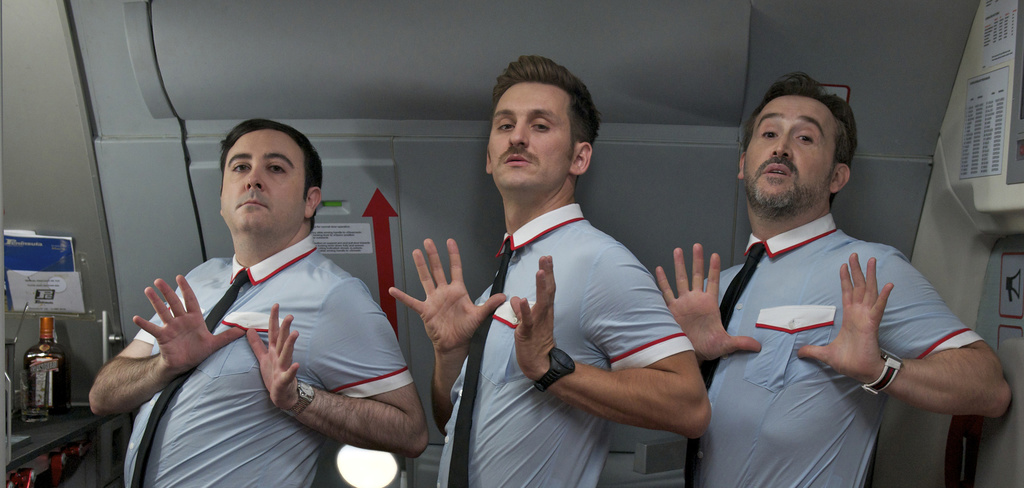
We are on Airbus A340 for Peninsula Flight 2549.
All the crew and passengers in Economy class have been drugged with a muscle relaxant by a flight attendant. In first class, the other flight attendants; Joserra (Javier Cámara), Fajardo, (Carlos Areces) and Ulloa (Raúl Arévalo) take shots of tequila.
There is something wrong with the plane: it can’t land.
In order to distract the first class passengers who eventually learn about their possible demise, Joserra, Fajardo, and Ulloa perform a lipsynched dance routine throughout the narrow aisles of the plane to The Pointer Sisters’ post-disco classic, “I’m So Excited!”, after which the English eponymous title takes its name. The dance sequence breaks the fourth wall as the trio perform it like an impromptu music video that they have definitely rehearsed before. The passengers are indeed distracted.
The original Spanish title, that is; “Los amantes pasajeros” has the double meaning of ‘the fleeting lovers’ and ‘the passengers lovers’ which refers to the numerous melodramatic (and classic Almodóvar) relationships both on board the plane and in Madrid.
The ‘fleeting loves’ may in particular be referring to the opening scene in which a couple portrayed by Almodóvar regulars Antonio Banderas and Penélope Cruz have short cameos which set off the chain of events which leads to the plane’s fault. What sounds like a tense thriller is of course delivered in colourful, campy light comedy in true Almodóvar fashion. There are gay love affairs, virgin psychics, ridiculous coincidences and secret hit men.
15. Moonrise Kingdom (2012) dir. Wes Anderson
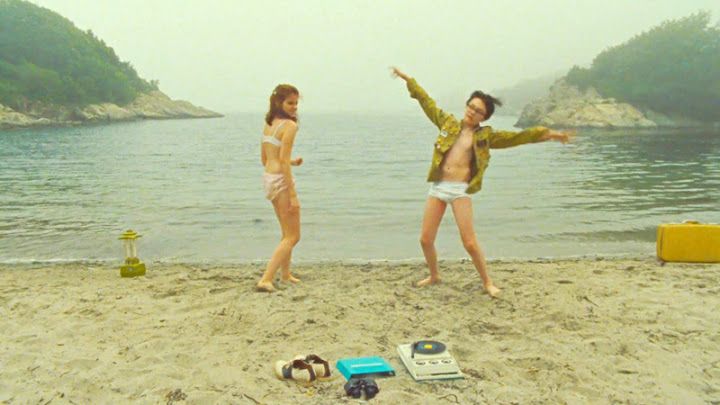
September, 1965. On the New England island of New Penzance, twelve-year-old Khaki Scout Sam Shakusky (Jared Gilman) and twelve-year-old bibliophile Suzy Bishop (Kara Hayward) successfully run away together to a secluded beach on the island after a year-long letter correspondence with one another. Both intelligent, introverted and generally unhappy with their familial situations, the two immediately develop a fairy-tale sort of innocent love for one another as they hide from angry adults and vengeful Khaki Scouts.
But for now, they’re alone. Susie packed her portable turntable and her favourite record album, Françoise Hardy’s “The ‘Yeh-Yeh’ Girl from Paris!” (1962, a.k.a Tous les garçons et les filles) and it’s time to play the nostalgic French tune “Le Temps de l’Amour” which seamlessly blends the contextually appropriate surfer music qualities with innocent themes of high chic yé-yé songs. The song itself is all about being young, in love, and adventurous.
The two children freely dance in their underwear. Toes in the sand. Flowers in her hair. It’s very “Summer with Monika”. Suzy sways while Sam energetically punching the air. The runaways get closer together as they begin to experiment the physical side of their infatuation.
Suzy: “Can you French kiss?
Sam: “I think so. Is there any secret to it?”
Suzy: “The tongues touch each other.”
Sam: “Okay. Let’s try.”
The coming-of-age film is Anderson’s first to be shot in 16mm film, capturing the time period’s nostalgic faded film quality and making the beach scene even more beautiful. Per Anderson, the narrative and themes of innocence and puppy love are strongly influenced by Waris Hussein’s “Melody” (or “S.W.A.L.K), and that it is essentially a remake of it.
16. American Beauty (1999) dir. Sam Mendes
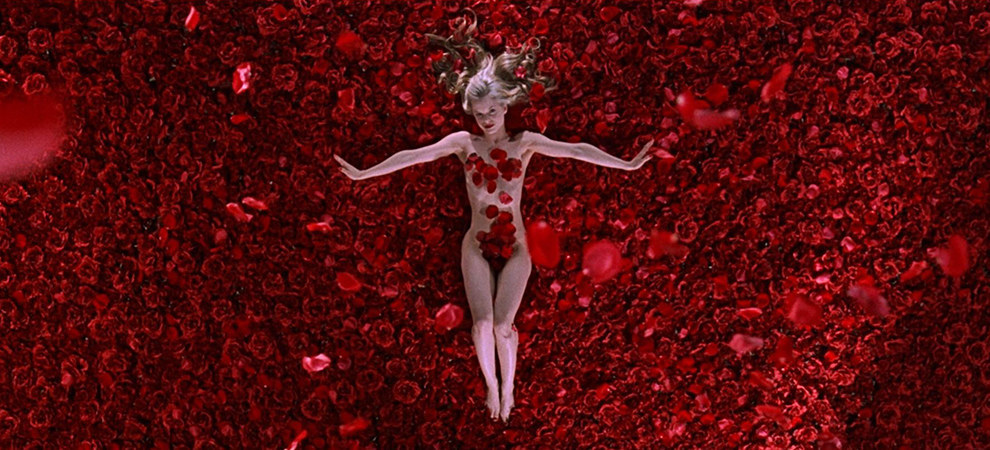
Leslie Burnham (Kevin Spacey) in in the audience of his sixteen-year-old daughter Jane’s (Thora Birch) high school gym. Jane and her illustrious friend, Angela (Mena Suvari), are part of the Spartanettes, i.e. the cheerleading squad.
And now it’s time for their half-time dance routine to intercut the basketball game. The cheerleaders wear dark green and white uniforms with long white socks and bowler hats, perhaps influenced by Bob Fosse’s musical “All That Jazz”. The Paula Abdul choreographed routine is set along to the high school band club’s mainly trumpeted rendition of “On Broadway” by The Drifters.
The squad is performing. There are many girls so at first Angela is just one among many. But soon, we zoom in. Leslie “looks closer”, and we see Angela is staring straight at him as she uses the bowler hat as a prop within her dance. In Leslie’s eyes, she’s in the centre, heralded by a spotlight.
The trumpet music dissipates and morphs into Thomas Newman tantalising score as Angela starts to dance more and more sexually. She winks and Leslie’s now the only person in the audience. The film starts to cut in a repetitive way, prolonging the intensity of Leslie’s enticement and longing for her to ultimately strip- which she does- and then it’s all red rose petals.
A familiar visual motif. Newman’s strings get even tighter as the peak of his fantasy is suddenly subsided back into reality. Where he is a huge audience with his wife Carolyn (Annette Benning) clapping next to him, Angela is no longer separated from the squad, and his daughter is right next to her.
The dance serves to introduce the audience to the source of Leslie’s new fond impetus in life. He quits, he starts exercising, smokes dope- all in the name of being younger again in response to a troubled marriage, unsuccessful career, a mid-life crisis and of course, the intense infatuation with his daughter’s best friend, Angela.
17. Girlhood (2014) dir. Céline Sciamma
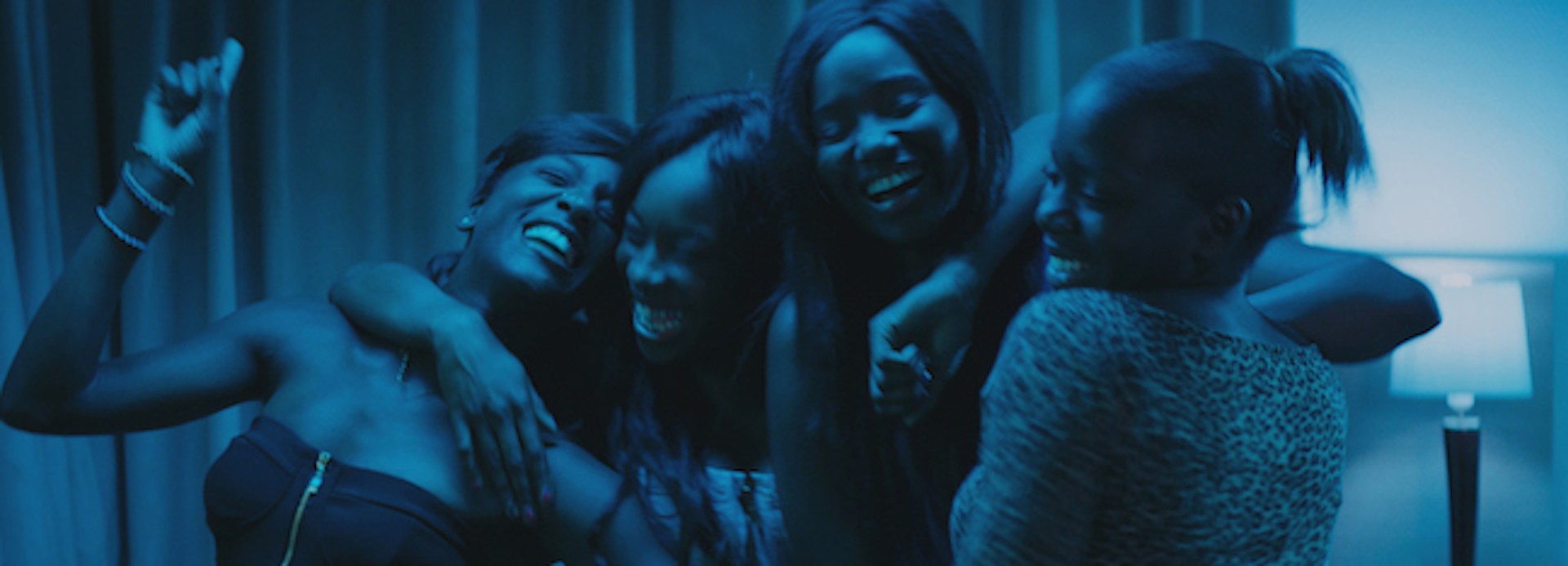
“Bande de filles” (literally translated into “Gang of Girls”) follows sixteen-year old Marieme (Karidja Touré) as she becomes part of a clique of girls at school, comprised of; Lady – the unofficial group leader, Fily, and Adiatou. The sorority of intimidating girls all have street cred, are from the rough side of town, and do not have any aversions to rule-breaking. The girls intimidate and antagonise others to get what they want.
Since everyone else doesn’t love them, they form a tight-knit bond of sorority and sisterhood in which they feel like they can depend on each other, regardless of what other people say. They steal and shoplift, and communally save up enough to book a hotel room for a night of vodka, weed, security-tagged dresses and, of course, Rihanna’s hit single “Diamonds”. Which leads us to the dancing.
It’s all distinctly blue. Mariame is lying on top of the fresh sheets of the rented be. The rest of the original three are already up and dancing along to Rihanna, which is playing from one of their phones. She immediately gets up and joins them, and for those two (-ish) minutes, all of them are living the high-life. The “Diamonds” life, if you will. The perhaps soon-to-be-returned dresses are theirs for tonight, and so is their future together.
Lady and Mariame do some rehearsed dance moves together in synchrony that they’ve been practicing on and teaching each other throughout the film. Soon enough, they forget about choreography and just start lip-synching and losing themselves to the beat. Eventually they erupt together and start singing the lyrics. Jumping around in a fancy hotel room. This is the event they’ve been waiting for.